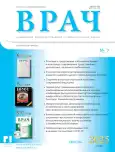Клинический опыт комплексного применения магнитной стимуляции и роботизированной механотерапии у пациентов с саркопенией вследствие двигательных нарушений после перенесенного инсульта
- Авторы: Кузнецов К.Д.1, Марченкова Л.А.1
-
Учреждения:
- Национальный медицинский исследовательский центр реабилитации и курортологии Минздрава России
- Выпуск: Том 36, № 7 (2025)
- Страницы: 58-61
- Раздел: Из практики
- URL: https://journals.eco-vector.com/0236-3054/article/view/689868
- DOI: https://doi.org/10.29296/25877305-2025-07-09
- ID: 689868
Цитировать
Полный текст
Аннотация
На примере клинического случая оценивается эффективность применения магнитной стимуляции и роботизированной механотерапии в комплексной программе реабилитации пациентки с саркопенией на фоне двигательных нарушений вследствие перенесенного острого нарушения мозгового кровообращения (ОНМК). Пациентка А., 70 лет, перенесшая ОНМК, а также с клинически и инструментально подтвержденным диагнозом саркопении, получала комплексный метод реабилитации, включающий курс магнитной стимуляции и роботизированной механотерапии на фоне базовой программы реабилитации. Продолжительность наблюдения – 3 мес. Оценка эффективности проводилась с применением визуальной аналоговой шкалы боли (ВАШ), функциональных тестов, метода тензодинамометрии на роботизированном лечебно-диагностическом комплексе с биологической обратной связью, на сенсорной дорожке.
По результатам курса реабилитации отмечено статистически значимое снижение болевого синдрома (до 3 баллов по ВАШ), увеличение показателей мышечной силы, скорости ходьбы, а также улучшение показателей реабилитационного диагноза по Международной классификации функционирования.
Комплексное применение магнитной стимуляции и роботизированной механотерапии является эффективным и безопасным методом лечения пациентов с саркопенией вследствие перенесенного ОНМК, обеспечивая как клиническое, так и морфологическое восстановление.
Полный текст
Об авторах
К. Д. Кузнецов
Национальный медицинский исследовательский центр реабилитации и курортологии Минздрава России
Автор, ответственный за переписку.
Email: marchenkovala@nmicrk.ru
ORCID iD: 0009-0002-3299-6984
SPIN-код: 4926-0693
Россия, Москва
Л. А. Марченкова
Национальный медицинский исследовательский центр реабилитации и курортологии Минздрава России
Email: marchenkovala@nmicrk.ru
ORCID iD: 0000-0003-1886-124X
SPIN-код: 9619-8004
доктор медицинских наук, доцент
Россия, МоскваСписок литературы
- Rosenberg I.H. Sarcopenia: origins and clinical relevance. J Nutr. 1997; 127 (5): 990S–991S. doi: 10.1093/jn/127.5.990S
- Roubenoff R. Origins and clinical relevance of sarcopenia. Can J Appl Physiol. 2001; 26 (1): 78–89. doi: 10.1139/h01-006
- Kilgour R.D., Vigano A., Trutschnigg B., et al. Cancer-related fatigue: the impact of skeletal muscle mass and strength in patients with advanced cancer. J Cachexia Sarcopenia Muscle. 2010; 1 (2): 177–85. doi: 10.1007/s13539-010-0016-0
- Schefold J.C., Bierbrauer J., Weber-Carstens S. Intensive care unit - acquired weakness (ICUAW) and muscle wasting in critically ill patients with severe sepsis and septic shock. J Cachexia Sarcopenia Muscle. 2010; 1 (2): 147–57. doi: 10.1007/s13539-010-0010-6
- Martone A.M., Bianchi L., Abete P. et al. The incidence of sarcopenia among hospitalized elderly patients: the results of the study Glisten. J Cachexia Muscle Sarcopenia. 2017; 8: 907–14. doi: 10.1002/jcsm.12224
- Sato Y., Yoshimura Y., Abe T. Phase Angle as an Indicator of Baseline Nutritional Status and Sarcopenia in Acute Stroke. J Stroke Cerebrovasc Dis. 2022; 31 (1): 106220. doi: 10.1016/j.jstrokecerebrovasdis.2021.106220
- Nozoe M., Kubo H., Kanai M. et al. Reliability and validity of measuring temporal muscle thickness as the evaluation of sarcopenia risk and the relationship with functional outcome in older patients with acute stroke. Clin Neurol Neurosurg. 2021; 201: 106444. doi: 10.1016/j.clineuro.2020.106444
- Abe T., Yoshimua Y., Imai R. et al. A Combined Assessment Method of Phase Angle and Skeletal Muscle Index to Better Predict Functional Recovery after Acute Stroke. J Nutr Health Aging. 2022; 26 (5): 445–51. doi: 10.1007/s12603-022-1777-9
- Lee H., Lee I.H., Heo J. et al. Impact of Sarcopenia on Functional Outcomes Among Patients with Mild Acute Ischemic Stroke and Transient Ischemic Attack: A Retrospective Study. Front Neurol. 2022; 13: 841945. doi: 10.3389/fneur.2022.841945
- Bellelli G., Zambon A., Volpato S. et al. The association between delirium and sarcopenia in older adult patients admitted to acute geriatrics units: Results from the GLISTEN multicenter observational study. Clin Nutr. 2018; 37 (5): 1498–504. doi: 10.1016/j.clnu.2017.08.027
- Scherbakov N., Sandek A., Doehner W. Stroke-related sarcopenia: specific characteristics. J Am Med Dir Assoc. 2015; 16 (4): 272–6. doi: 10.1016/j.jamda.2014
- Scherbakov N., von Haehling S., Anker S.D. et al. Stroke induced Sarcopenia: muscle wasting and disability after stroke. Int J Cardiol. 2013; 170 (2): 89–94. doi: 10.1016/j.ijcard.2013.10.031
- Nishioka S., Yamanuchi A., Matsushita T. et al. Validity of the circumference of the tibia for assessing skeletal muscle mass in patients after stroke. Nutrition. 2021; 82: 111028. doi: 10.1016/j.nut.2020.111028
- Кузнецов К.Д., Марченкова Л.А., Стяжкина Е.М. и др. Способ медицинской реабилитации пациентов с саркопенией на фоне последствий острого нарушения мозгового кровообращения. Патент RU 2024113417, 17.05.2024 [Kuznecov K.D., Marchenkova L.A., Styazhkina E.M. et al. Sposob medicinskoj reabilitacii pacientov s sarkopeniej na fone posledstvij ostrogo narusheniya mozgovogo krovoobrashcheniya. Patent RU 2024113417, 17.05.2024 (in Russ.)].
Дополнительные файлы






